
Centre of Jaina Studies Newsletter: SOAS - University of London
For what has become a rite of early spring, scholars, students, and community members gathered for the 11th annual Jaina Studies Workshop at SOAS on 12-13 March, organized by SOAS, Lund University and the V&A. The topics of the presentations were wide-ranging, from philosophy, logic, textual studies, and karma theory to the Ājīvikas, rituals of confession and atonement, and narratives of Pārśvanātha and Mahāvīra.
The conference opened on Thursday evening with Bansidhar Bhatt (University of Münster) delivering the 9th Annual Jaina Lecture in which he argued that Pārśva, the twenty-third Jina, is a legendary figure. His historicity, he maintained, is doubtful for a number of reasons. There is no mention of Pārśva in any early nonJain texts, and his biographies do not contain the names of any contemporary religious figures or historical rulers. The reason that he is said to have lived in historical times, just 250 years prior to Mahāvīra, is that conversion stories are found in Śvetāmbara texts, such as the well-known dialogue in the Uttarajjhāyāsutta between Keśi and Gautama, where Keśi, a follower of Pārśva, adopts the five mahāvratas as preached by Mahāvīra. These stories were developed, in part, to resolve the problem of two sets of mendicant vows. Historically, the earlier was the vow of sāmāyika and the observance of caūjjāma-yama, or fourfold restraints, which Bhatt believes the Jinakalpika monks followed, while the later were the chedopasthāpanīya and pañca-yama, or the five mahāvratas, which the Therakalpika monks observed. He understands aparigraha to be the additional vow and maintains that the vow of non-possession did not exist prior to the second century BCE. The stories linking Mahāvīra with the five mahāvratas, as well as those of the first and last Jinas preaching the five mahāvratas and the middle 22 the fourfold restraints, developed subsequent to this time. However, the narratives shifted the change in the vratas to earlier times, namely, during the lifetime of Mahāvīra. He concluded that these stories are all legendary and provide no evidence for the existence of Pārśva.
Textual studies of Śvetāmbara works included an analysis of the composition of the Uttarajjhāyāsutta by Herman Tieken (Leiden University). Although Charpentier concluded that it is difficult to detect a plan in the arrangement of this text, Tieken believes that it is organized according to a definite plan. The first and second chapters, dealing with mendicant conduct and respect for the teacher (viṇaya) and the 22 parīsahas, serve as an introduction to the text. At the beginning of chapter three, the arrangement of the text into four sections is outlined (tr. Jacobi): "Four things of paramount value are difficult to obtain here by a living being: human birth (mānusatta), instruction in the law (suī), belief in it (saddhā), and energy in self control (saṃjamammi ya vīriyam)." These four topics are repeated at 3.11. The following chapters are arranged according to these four topics: mānusatta 3-9, suī 10-11, saddhā 12-27, and saṃjamammi vīriya/tava 28-36. Furthermore, except for the saddhā section, each contains verses that serve as an introduction to the topics contained therein. Thus, the arrangement of this text is not random as Charpentier had assumed.
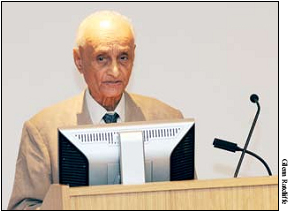
Bansidhar Bhatt (University of Münster) delivered the 9th Annual Jaina Lecture.
In "The Bee and the Mendicant: Two Different Versions in the Extant Jaina Āgamas," Kenji Watanabe (Tokyo) emphasized the importance of readings found in the Dasaveyāliyacuṇṇi, although the sutta, edited by Ernst Leumann, is regarded as the standard edition. In the latter, the locative plural ending -esu is used, while in the Cuṇṇi the oblique plural ending -ehi(ṃ), that of eastern dialect texts, is found in a number of instances. One of the passages showing these differences in case endings is the description of a mendicant collecting alms in the manner of a bee collecting a little nectar from a number of flowers. These endings are identical with those found in Aśokan inscriptions from the west and east, respectively. Watanabe believes that the Cuṇṇi readings are better and more original than those in the extant text on which Leumann's edition is based
Three presentations focused on Digambara texts. Prem Suman Jain (Shravanabelagola) shared his on-going research on manuscripts of the Bhagavatī Ārādhanā composed in Śaurasenī Prākrit by Ācārya Śivarāya or Śivakoṭī (ca. 2nd century CE). Although several editions of this text have been published along with commentaries and Hindi translations, work on a critical edition of the Prakrit verses has yet to be undertaken. To date, Jain has collected information on 39 manuscripts in India, and he discussed the significance of one rare paper manuscript (no. 1112) stored at the Bhandarkar Oriental Research Institute, Pune. He discussed the importance of this manuscript for critical textual editing by comparing words found in the Pune manuscript with those found in Pt. Kailash Shastri's edition and in the Vijayodayāṭīkā of Aparājita Sūri. He compared Prakrit gāthās from the Pune manuscript with those quoted by Śricandra in his Apabhraṃśa Kahākosu (11th century) and also with similar passages found in the Śvetāmbara Āvaśyakacūrṇī and nirjukti-niryukti and Bṛhatkalpabhāṣya. He also mentioned that this manuscript contains the Sanskrit gloss of some words by an unknown Muni that may be of use in textual editing.
Sin Fujinaga (Miyakonojō Kōsen) talked about the significance of Pūjyapāda's Sarvārthasiddhi, the earliest commentary on the Tattvārthasūtra accepted by the Digambaras, as a repository for quotations from other sources, a number of which cannot be traced to extant texts. He distinguishes between those passages that are quoted in support of Pūjyapāda's views, which he considers authentic, and those that are quoted for the purposes of refutation. He pointed out that some of the supporting passages are from Śvetāmbara āgamas and others are from sources that are thought to be of Yāpanīya origin. Thus, it is possible that Pūjyapāda was writing at a time when philosophers did not have ideas that were so different from one another and when there may have been more accommodation across sectarian traditions than is evidenced in later writings.
Jayendra Soni (University of Marburg) concentrated on the interpretation of key philosophical terms in the Ṣaṭkhaṇḍāgama and its ninth-century commentary, the Dhavalā by Vīrasena. Although the relative dating of this text with the Śvetāmbara Prajñāpanāsūtra remains a matter of sectarian dispute, both were composed at a time when Jain authors had devised methods of argumentation and organization and are significant in that they rendered superfluous the study of earlier āgamas. Out of fourteen terms mentioned in association with the jīva in Ṣaṭkhaṇḍāgama 1.1.4, Soni discussed Vīrasena's views about two qualities of the soul, jñāna and darśana, as well as his understanding of cognition, or upayoga.
Continuing the theme of logic and philosophy, Piotr Balcerowicz (University of Warsaw) discussed the shortcomings of numerous attempts at the formalization of syādvāda. He believes that those who have used the constructivist approach have failed to understand the structure of syādvāda. Instead, they have assumed that in syād- vāda statements can be hierarchically ordered in relation to their truth values, but this modern idea is not what is actually represented here. In interpreting syādvāda, one should use formalization only to reproduce its real structure as found in these texts, and no Jain text says that at least one of the seven statements in the sevenfold predication is false. Instead, they say that all are equally true because each statement emphasizes one predicate or property, while in avaktavyam statements, both properties are not emphasized. He concluded by distinguishing between nayavāda, which tries to determine whether a given statement is true, and syādvāda, which deals with all possible things you can say about an object.
Anne Clavel (University of Lyon) explored the apparent contradiction in the Nandīsūtra regarding the classification of sense cognition. In some sūtras the traditional Jain classification of sense cognition (matijñāna) as a type of indirect knowledge (parokṣa) is found, in agreement with the Sthānāṅgasūtra and the Tattvārthādhigamasūtra, where first two kinds of knowledge (sensory and scriptural) are indirect and the remaining three (clairvoyant, telepathic, and omniscient) are direct (pratyakṣa). However, in the Nandīsūtra 1- 5, sensory knowledge is considered to be a type of pratyakṣa, which in Jainism reflects a new conception regarding perceptual knowledge. Some scholars have seen these two positions as contradictory and indicative of a situation where the Nandīsūtra could not depart from the older tradition. However, Jinabhadra (6th century CE) did not view this as such. Instead, in the Viśeṣāvaśyakabhāṣya and his autocommentary, he states that these different classifications are not in conflict because they represent two perspectives. Matijñāna is a type of direct knowledge from an empirical or conventional standpoint, but it is indirect knowledge from the transcendental standpoint.
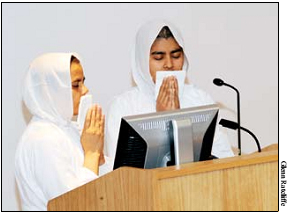
Rituals of confession and atonement were the subject of talks by Nalini Balbir (University of Paris) and Paul Dundas (University of Edinburgh). Balbir contrasted two Prakrit works on layman's atonements. The Sāvayapacchitta is a short work found in only two manuscripts of 12 and 16 verses. Both of these are appended to manuscripts containing the Jītakalpasūtra of Jinabhadra, which deals with atonements for Śvetāmbara mendicants. With no commentary, they appear to have been considered as an appendix to the work on mendicant atonements and represent something of a deadend. In contrast, the Saḍḍhajīyakappa, written sometime between 1271 and 1300 by the Tapā Gaccha monk Dharmaghoṣa, appears to have been more popular, with several Sanskrit commentaries. Comprised of some 842 stanzas it is much more detailed and possibly was an elaboration of the Sāvayapacchitta. For example, in the Saḍḍhajīyakappa there is mention of hiṃsā that is applicable only to lay people. Also, atonements are not seen exclusively from a man's perspective, and the equality of men and women with respect to atonements is specifically stated. Both texts contain a number of specialized technical terms, which Balbir discussed, along with terms for various types of fasts prescribed as atonements. She observed that texts such as these, which deal with fasts as atonements, have tended to become obsolete because the performance of pratikramaṇa provides a large-scale atonement for everything in lay life.
In a continuation of his research on polemics, Paul Dundas examined a difference of opinion in the Tapā and Kharatara Gacchas regarding the correct performance of iriyāvahiyāpaḍikkamaṇa, formally expressing regret for harm to life forms in the course of moving from one place to another. The issue of whether this ritual should be performed before or after the obligatory action (āvaśyaka) of sāmāyika was the subject of bitter debate between the Tapā Gaccha 16th-century intellectual Dharmasāgara and Jayasomagaṇin of the Kharatara Gaccha. Until the 10th or 11th century there appears to have been a consensus about pratikramaṇa in the various Śvetāmbara mendicant lineages, but around this time new gacchas were established and a difference in opinion arose regarding this, with the Tapā Gaccha understanding that it should be performed before sāmāyika. In light of this, Dundas discussed various interpretations of conflicting accounts of the timing of this ritual in Śvetāmbara texts, including the Āvaśyakacūrṇī, Mahāniśīthasūtra, and the story of Pokkhali's visit to the fasting hall in the Bhagavatīsūtra.
Olle Qvarnström (University of Lund) focused on the significance of the Niyativāda hymn in the Dvātriṃśikā, attributed to Siddhasena Divākara (6th century CE), for furthering our understanding of the Ājīvika tradition. It is commonly accepted that no primary Ājīvika source appears to have survived, and thus our knowledge is dependent upon what is found in the texts of their rivals, which in all probability is biased. Qvarnström believes this hymn is of great historical importance because he thinks it may be an original Ājīvika text that was edited by the compiler of the Dvātriṃśikā and thus is an impartial account of their philosophy. Here, central Ājīvika doctrines, such as niyati and the abhijātis, are described, but it also contains alternative views of cosmology. Causality, which is illusory and associated with the mind, is understood to be valid from the perspective of conventional truth, while niyati is valid from the perspective of absolute truth. The text also hints at a higher level of reality understood through meditation. The account found here shows that during the 6th century CE the Ājīvika were still engaged in polemics with Jains and Buddhists and their philosophy may have encompassed alternative realities.
Johannes Bronkhorst (Univeristy of Lausanne) raised the question of whether there was relic worship in early Jainism. He examined the story in the Jambūdvīpaprajñapti of the disposal of the body of Ṛṣabha and those of his Gaṇadharas and the monks who died at the same time. Most of the death rituals are identical, including cremating the bodies on three funeral pyres and constructing three stūpas. There is no mention of what happened to the remains of the Gaṇadharas and monks, but the bones of the Jina were put into boxes and taken to heaven by the gods. At one time, there may have been a more coherent version of this story in which the remains, including those of the Tīrthaṅkara, were placed in stūpas and worshipped. However, over time, relic worship in Jainism was discouraged and through stories such as this, Jains were convinced that there were no authentic bodily relics here. The opposite appears to have taken place in Buddhism, where relic worship flourished, and stories were developed about the widespread distribution of the Buddha's relics.
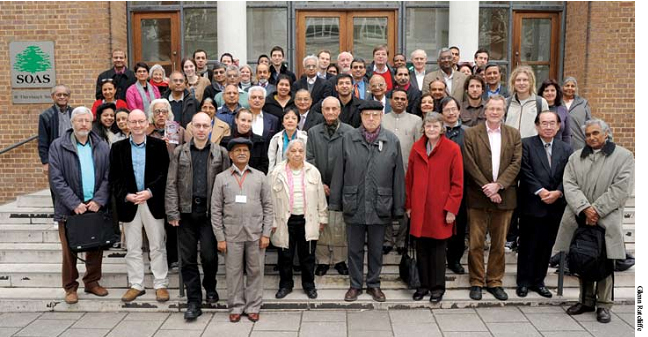
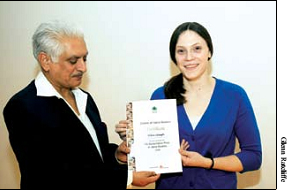
Ellen Gough was awarded the 2007/08 Dissertation Prize for her SOAS MA dissertation on 'Jaina Tantra, Mantra and the Ṛṣimaṇḍala Yantra'. The prize, sponsored by the N. K. Sethia Foundation through the Institute of Jainology, was presented by Harshad N Sanghrajka, an alumnus of the SOAS MA in Jaina Studies.
In the final presentation of the day, Peter Flügel (SOAS) examined the significance of the term vera in the reconstruction of a proto-karma theory in Jainism and in the pre-history of Indian philosophy. As noted by Dixit, Ohira and Bollée, the notion of karma emerged from the concept of hostility or revenge (vera) as found in the Āyāra, Sūyagaḍa, and Viyāhapannatti. In the earliest strata of these texts, vera is related to the concept of soya, energy discharged by a victim's soul in the form of a stream. Although this term is seldom used in later texts, in Viyāhapannatti 1.8.2 the expression "being touched by hostility" (vera) of the victim is used. In texts, such as the Uttarajjhāyā and Dasaveyāliya, the sense of vera is hostility or anger, not revenge. This theory has been largely ignored by scholars in discussions regarding the evolution of karman theory in South Asia. However, Flügel argued that, in addition to the three currently dominant theories of the origin of the concept of karman, that is, (1) creatio ex nihilo by one or more unknown thinkers, (2) post hoc rationalisation of scripted ritual practice, (3) reworked survivals of a vanished civilisation (traceable in Jainism and Buddhism), a fourth line of investigation should be considered based on the hypothesis that the theories of karman emerged as rationalisations of popular religious conceptions still observable today in Hindu notions of transactions of substance-code which through the Jaina ontological dualism and interiorisation of action become transformed into the notion of karman as a material substance, and hence calculable from the trasncendent perspective of the soul.
The contributions to the conference are going to be published in a volume in honour of Professor Dr Willem Bollée. Please check the CoJS website for further updates: www.soas.ac.uk/jainastudies.
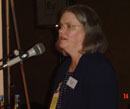 Kristi L. Wiley
Kristi L. Wiley